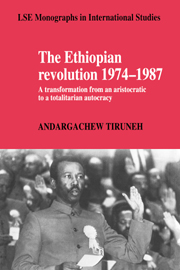 The Ethiopian Revolution 1974–1987
The Ethiopian Revolution 1974–1987 Book contents
- Frontmatter
- Contents
- List of maps and tables
- Acknowledgements
- List of abbreviations
- Map 1 The Horn of Africa
- Map 2 Administrative divisions
- 1 The background to the emergence of the structural crisis
- PART I THE COLLAPSE OF THE OLD-STATE (JANUARY–NOVEMBER 1974)
- PART II THE FORMATIVE YEARS OF THE POST-REVOLUTIONARY ORDER (DECEMBER 1974–FEBRUARY 1977)
- 4 The socio-economic reforms of 1975
- 5 The upsurge of political organizations
- 6 Scientific socialism and the structure of the government
- 7 From a junta to an autocratic dictatorship
- PART III CONSOLIDATION OF POWER (FEBRUARY 1977–SEPTEMBER 1987)
- Postscript
- Appendix: chronology of events
- Notes
- Bibliography
- Index
- LSE MONOGRAPHS IN INTERNATIONAL STUDIES
5 - The upsurge of political organizations
Published online by Cambridge University Press: 18 December 2009
- Frontmatter
- Contents
- List of maps and tables
- Acknowledgements
- List of abbreviations
- Map 1 The Horn of Africa
- Map 2 Administrative divisions
- 1 The background to the emergence of the structural crisis
- PART I THE COLLAPSE OF THE OLD-STATE (JANUARY–NOVEMBER 1974)
- PART II THE FORMATIVE YEARS OF THE POST-REVOLUTIONARY ORDER (DECEMBER 1974–FEBRUARY 1977)
- 4 The socio-economic reforms of 1975
- 5 The upsurge of political organizations
- 6 Scientific socialism and the structure of the government
- 7 From a junta to an autocratic dictatorship
- PART III CONSOLIDATION OF POWER (FEBRUARY 1977–SEPTEMBER 1987)
- Postscript
- Appendix: chronology of events
- Notes
- Bibliography
- Index
- LSE MONOGRAPHS IN INTERNATIONAL STUDIES
Summary
When the Derg took power in the summer of 1974, the most important demand of the opposition was the establishment of a Provisional People's Government which would represent more sections of the population than did the Derg and which would pave the way for the establishment of a non-provisional government. If the opposition had had its way, then the Provisional People's Government and/or the non-provisional government that the latter would have created might have been expected to adopt socio-economic and political reforms demanded by the revolutionary movement of the time. Nevertheless, the Derg felt that it could deliver whatever another ‘progressive’ provisional or non-provisional government could deliver; it, therefore, continued to monopolize power and to adopt reforms, while at the same time promising to hand power over to a government of the people.
Thus, as discussed in the previous chapter, the Derg adopted, in 1974 and 1975, Ethiopian Socialism and, in accordance with this, a series of nationalization measures with far-reaching social and economic implications. Again, as will be noted in this chapter, in April 1976 the Derg adopted a National Democratic Revolution Programme which gave priority to the establishment of a Leninist Party rather than the formation of a non-provisional government. Ethiopian Socialism can be described as a variant of African socialism and the National Democratic Revolution Programme of Ethiopia as a variant of scientific socialism; it is with the processes of this ideological shift of the Derg that the present chapter is concerned.
- Type
- Chapter
- Information
- The Ethiopian Revolution 1974–1987A Transformation from an Aristocratic to a Totalitarian Autocracy, pp. 123 - 155Publisher: Cambridge University PressPrint publication year: 1993
